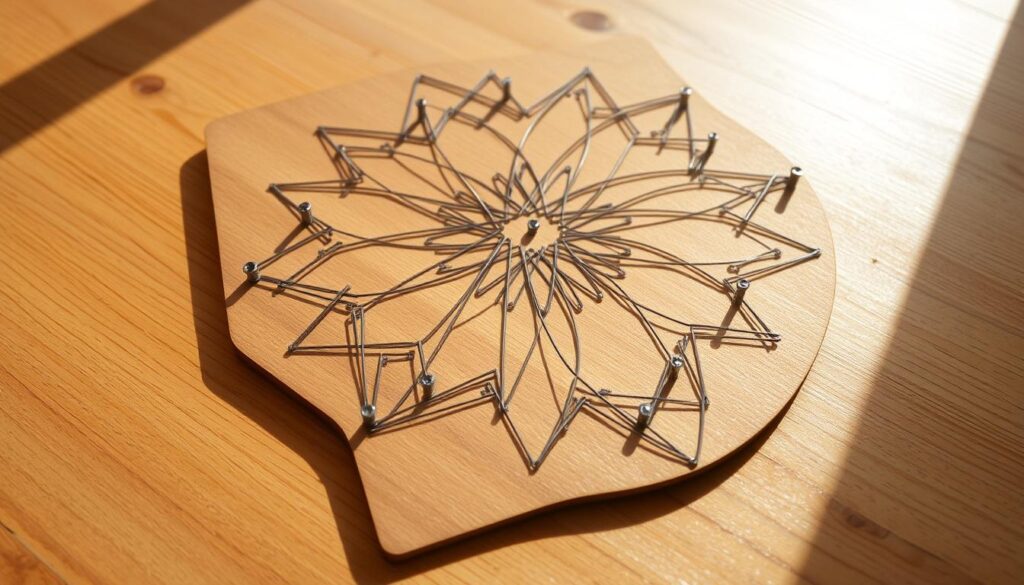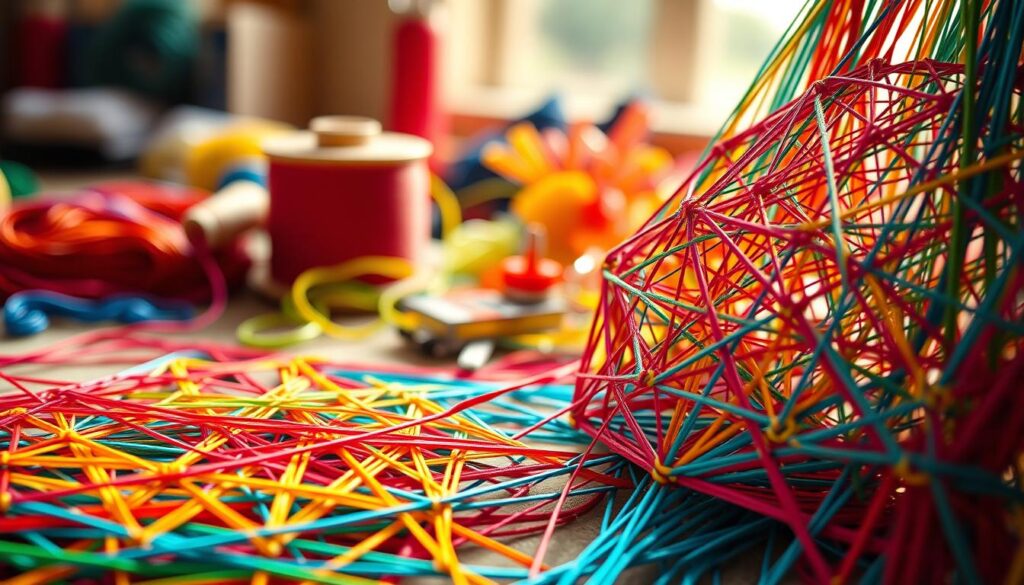Ever wanted to turn basic supplies into eye-catching decor? This creative craft lets you transform wood, nails, and thread into stunning geometric patterns or whimsical shapes. Whether you’re crafting a moon-and-stars accent for a guest room or designing intricate wall art, the possibilities are endless.
You don’t need fancy tools to start. A piece of sanded wood, embroidery floss, and a printed template are all it takes to create your first piece. Popular tutorials show how even beginners can achieve professional-looking results with patience and clear instructions.
The technique gained popularity in the 1960s as both an educational tool and decorative art form. Today, it’s embraced by DIY enthusiasts for its blend of simplicity and sophistication. Projects range from kid-friendly designs to elaborate installations that wow guests.
We’ll walk you through every step, from selecting materials to mastering advanced color-blending techniques. Photos and video guides (like those by Viana Boenzli) make it easy to follow along. Ready to discover how nails and thread can become your new favorite hobby?
Key Takeaways
- Create striking decor using basic materials like wood, nails, and embroidery thread
- Suitable for all skill levels, with projects ranging from beginner-friendly to expert-level
- Includes historical context and modern applications for home decoration
- Step-by-step visual guides ensure success for first-time crafters
- Versatile technique adapts to seasonal themes or personalized gift ideas
Getting Started with String Art
Transform everyday materials into geometric wonders with this timeless craft. Whether you’re revamping a blank wall or making personalized gifts, the journey begins with mastering foundational skills.
From Classroom to Living Room
This technique traces back to 19th-century math lessons, where educators like Mary Everest Boole used thread to explain angles. By the 1960s, crafters reimagined it as stylish wall decor—a trend that’s surged again with modern DIY culture.
Your Toolkit for Success
Gather these essentials to begin:
- Sanded wood panels (6×6″ or 12×12″ work well)
- 1″ nails with flat heads
- Cotton embroidery floss for vibrant colors
- Basic hammer and pencil
Prep your surface by sanding edges and applying polyurethane for durability. Don’t worry if you’re not an artist—printed patterns secured with painter’s tape ensure crisp outlines. Start with single-shape designs like hearts or stars before tackling complex layouts.
Pro tip: Use a sewing needle to thread floss smoothly between nails. For mixed-media flair, add painted lettering after completing your thread work.
Step-by-Step Guide to Creating Your String Art Masterpiece
Crafting your first piece feels like solving a puzzle where every nail and thread placement matters. This hands-on process combines precision with creativity, turning raw materials into dimensional decor. Let’s break down the essentials for flawless execution.

Design, Template, and Layout Preparation
Start by choosing a pattern that matches your skill level. Beginners thrive with bold shapes like circles or triangles, while complex florals suit experienced crafters. Printed templates work best for crisp outlines—tape them to sanded wood using painter’s tape for stability.
Mark nail positions with a pencil, spacing dots ½” apart along the design edges. For curved sections, reduce spacing to ¼” for smoother lines. Not confident in freehand sketching? Digital tools like Canva or Adobe Illustrator help create custom patterns.
| Template Type | Best For | Tools Needed |
|---|---|---|
| Hand-Drawn | Simple shapes | Graph paper, ruler |
| Digital Print | Detailed designs | Printer, scissors |
| Stencil | Repeating patterns | Plastic sheets, craft knife |
Pre-Drilling, Nail Placement, and Setting Your Canvas
Drill pilot holes at each marked spot using a 1/16″ bit. This prevents wood splitting and keeps nails upright. Position nails ⅓” deep, leaving enough height to wrap thread securely. Work in sections—complete outer edges first, then fill internal details.
Pro tip: Use needle-nose pliers to adjust crooked nails. Always wear safety glasses when hammering. For more guidance, explore our string art for beginners resource with foolproof starter patterns.
Mastering String Art Techniques for Creative Projects
Elevate your craft from basic patterns to gallery-worthy displays through strategic approaches. Whether aiming for organic flow or pixel-perfect precision, your method shapes the final result.

Freehand Freedom vs Template Precision
Freehand designs let imagination lead, creating one-of-a-kind pieces with uneven charm. They work well for abstract shapes but risk inconsistent spacing. Pre-printed templates ensure symmetry—ideal for typography or geometric patterns—though some crafters find them less personal.
Proven Methods for Flawless Results
Keep threads taut by wrapping clockwise around nails. Pre-drill holes prevent wood splits. Secure knots with a dot of hot glue—invisible under layers. Change colors mid-project by tying new threads at the back. One crafter transformed her living room with a heart design using this method, alternating red and white floss for 3D effects.
Color Play and Dimension Tricks
Try ombré effects by blending similar hues or bold contrasts for pop-art vibes. Layer threads vertically then horizontally for woven texture. Metallic floss catches light beautifully in sunlight. One winter-themed piece used silver threads over navy blue felt, creating frost-like shimmer.
Remember: There’s no “wrong” way to experiment. Mix materials like yarn with embroidery floss. Try circular boards instead of square ones. Your unique style emerges through playful exploration.
Conclusion: Bringing Your String Art Projects to Life
Turn humble supplies into striking decor with a technique that blends precision and imagination. You’ve learned how to choose materials, prep templates, and weave threads into dynamic patterns. Every successful piece starts with careful planning—sanding wood, spacing nails evenly, and selecting colors that pop.
Patience pays off when wrapping threads around nails. Whether following a step-by-step tutorial or experimenting freely, your effort transforms basic tools into conversation-starting displays. Remember: even simple shapes become extraordinary with layered textures or clever color blends.
Share your creations with fellow crafters online or gift them to friends—each project carries your unique touch. Keep our tips handy for future designs, and don’t hesitate to mix techniques. A well-executed piece doesn’t just fill wall space—it tells a story through every twist and knot.
Ready to make your mark? Grab that hammer, pick vibrant threads, and let your creativity shine. Home decor has never felt this personal—or this fun.

